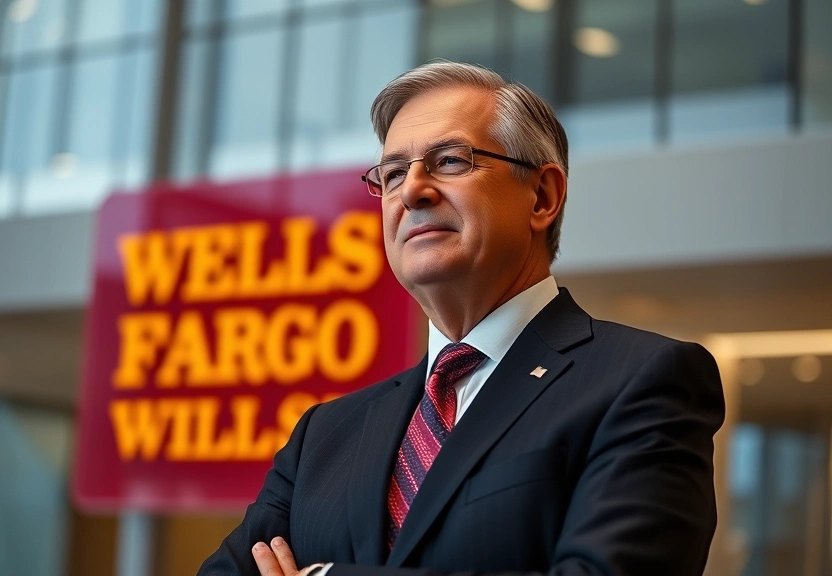Wells Fargo Elevates CEO Charles Scharf to Chairman Position
In a strategic move aimed at strengthening its leadership and shaping the future of the banking industry, Wells Fargo has announced the elevation of Charles Scharf from CEO to the position of Chairman of the Board. This decision reflects the bank’s commitment to enhancing its corporate governance and aligning its leadership with the evolving needs of its stakeholders. Scharf’s ascension to Chairman comes during a period of significant transformation for Wells Fargo, which has been focused on rebuilding trust and improving operational efficiency following a series of challenges in recent years.

Scharf, who has served as CEO since October 2019, has been instrumental in implementing key initiatives that aim to restore the bank’s reputation and enhance shareholder value. His appointment as Chairman not only consolidates his influence within the organization but also sets a clear direction for the bank as it navigates the complexities of the modern banking landscape. This article delves into the implications of Scharf’s new role, the challenges faced by Wells Fargo, and the future of corporate leadership in the banking industry.
The Significance of Scharf’s Promotion
Charles Scharf’s promotion to Chairman is significant for various reasons. It signals a renewed focus on leadership stability and a commitment to long-term strategic goals. The merger of the CEO and Chairman roles is a practice that underscores a unified vision, particularly in a time when Wells Fargo is striving to regain confidence among its customers and investors.
Strengthening Corporate Governance
By elevating Scharf to the Chairman position, Wells Fargo is reinforcing its commitment to effective corporate governance. The alignment of the CEO and Chairman roles can lead to more cohesive decision-making and clearer accountability. This is crucial in a banking environment that demands transparency and ethical leadership.
Enhancing Stakeholder Trust
Trust is paramount in the banking industry, and Scharf’s leadership is viewed as a stabilizing force. His promotion is expected to inspire confidence among stakeholders, including customers, employees, and investors. As Wells Fargo works to rebuild its reputation, having a well-respected figure at the helm is vital to restoring trust.
Charles Scharf: A Profile in Leadership
Before joining Wells Fargo, Charles Scharf held notable positions at JPMorgan Chase and Visa, where he honed his skills in corporate leadership and strategic management. His extensive experience in the financial sector has equipped him with the insights necessary to navigate the complexities of the banking industry.
A Track Record of Transformation
Since assuming the role of CEO, Scharf has spearheaded various initiatives aimed at transforming Wells Fargo’s operations. Under his leadership, the bank has focused on enhancing its digital offerings, improving customer service, and investing in technology to streamline operations. These changes are essential for positioning Wells Fargo as a competitive player in an increasingly digital banking environment.
Vision for the Future
Looking ahead, Scharf envisions a Wells Fargo that prioritizes innovation while maintaining strong ethical standards. His dual role as CEO and Chairman allows him to implement a cohesive strategy that aligns the bank’s operational goals with its long-term vision.
Challenges Facing Wells Fargo
Despite the positive outlook, Scharf faces significant challenges as he transitions into his new role. The banking industry is undergoing rapid changes, driven by technological advancements and shifting consumer expectations. Furthermore, Wells Fargo is still recovering from past scandals that have left a lasting impact on its reputation.
Regulatory Scrutiny
Wells Fargo has been under the spotlight due to regulatory issues stemming from its past misconduct. The bank has made strides in addressing these concerns, but ongoing regulatory scrutiny remains a hurdle. Scharf’s leadership will be crucial in ensuring compliance and fostering a culture of accountability within the organization.
Competition in the Banking Sector
The banking industry is more competitive than ever, with fintech companies disrupting traditional banking models. Scharf must navigate this competitive landscape by leveraging technology and innovation to meet the evolving needs of consumers. This includes enhancing digital banking services and improving user experiences to retain customers.
The Future of Corporate Leadership in Banking
The elevation of Charles Scharf to Chairman of Wells Fargo is indicative of a broader trend in corporate leadership within the banking sector. As companies face unprecedented challenges and transformations, effective leadership becomes paramount. The following points highlight the future of corporate leadership in the banking industry:
- Focus on Ethical Leadership: The importance of ethical leadership is gaining prominence as banks seek to rebuild trust. Leaders must prioritize transparency and integrity in their decision-making processes.
- Embracing Technology: As digital transformation reshapes the banking landscape, corporate leaders must embrace technology to drive innovation and improve customer experiences.
- Agility and Adaptability: The ability to respond swiftly to market changes and consumer demands is crucial. Leaders must foster a culture of agility within their organizations.
- Stakeholder Engagement: Engaging with stakeholders, including employees, customers, and investors, is essential for building trust and ensuring long-term success.
- Commitment to Diversity and Inclusion: A diverse leadership team can bring fresh perspectives and drive better decision-making, making it a priority for future corporate leaders.
FAQs about Wells Fargo and Charles Scharf
1. Who is Charles Scharf?
Charles Scharf is the CEO and now Chairman of Wells Fargo, with extensive experience in the banking and financial services sectors. He has previously held leadership roles at JPMorgan Chase and Visa.
2. What does it mean for Scharf to become Chairman?
Scharf’s elevation to Chairman consolidates his leadership role, allowing for unified decision-making and a cohesive vision for the bank’s future.
3. What challenges does Wells Fargo face?
Wells Fargo faces challenges related to regulatory scrutiny, competition from fintech companies, and the need to rebuild its reputation following past scandals.
4. How has Scharf influenced Wells Fargo since becoming CEO?
Since becoming CEO, Scharf has implemented significant operational changes, focusing on enhancing digital offerings, improving customer service, and investing in technology.
5. What are the trends in corporate leadership in banking?
The trends include a focus on ethical leadership, embracing technology, agility, stakeholder engagement, and a commitment to diversity and inclusion.
Conclusion
The elevation of Charles Scharf to the Chairman position at Wells Fargo marks a pivotal moment for the bank and the broader banking industry. His extensive experience and strategic vision are expected to play a crucial role in guiding the bank through its ongoing transformation. As Wells Fargo continues to navigate challenges and seize opportunities, Scharf’s leadership will be instrumental in solidifying the bank’s position in an increasingly competitive landscape. The banking industry is evolving, and with strong corporate leadership, institutions like Wells Fargo can adapt and thrive in the face of change.
📰 Original Source
Este artigo foi baseado em informações de: https://www.investing.com/news/stock-market-news/wells-fargo-board-to-appoint-ceo-scharf-as-chairman-4164558


